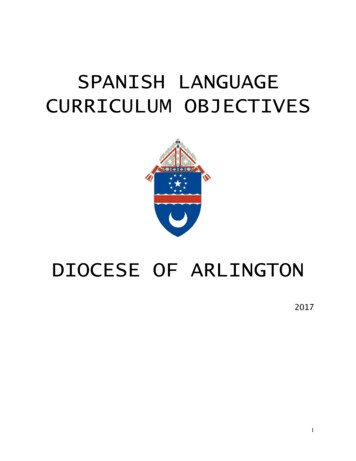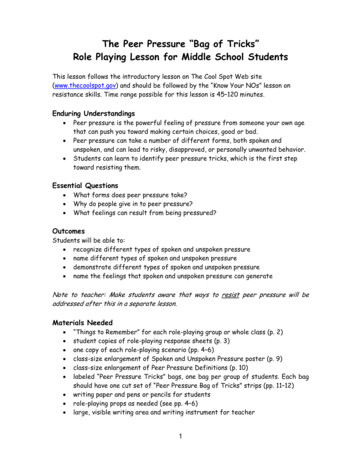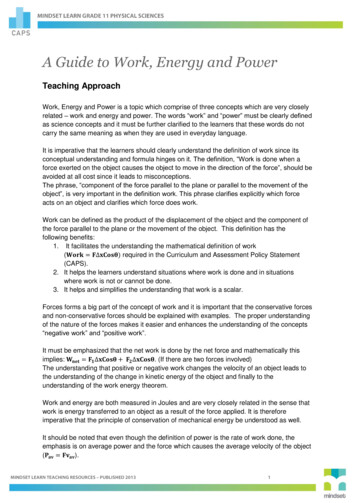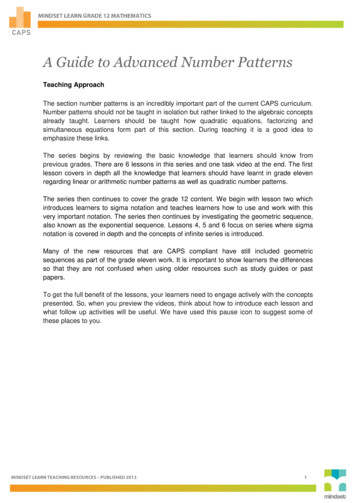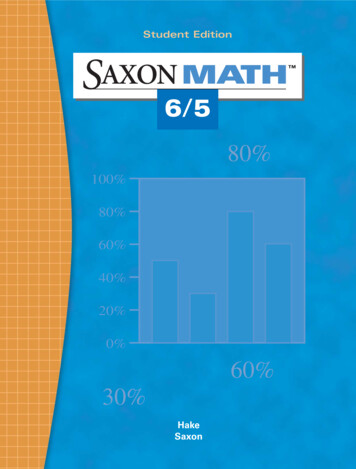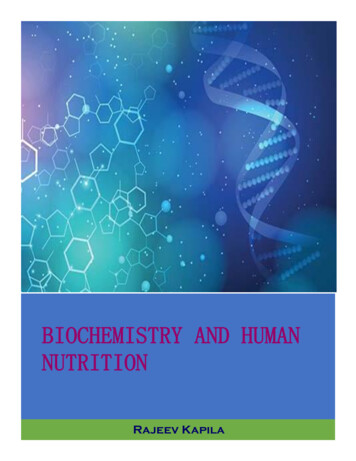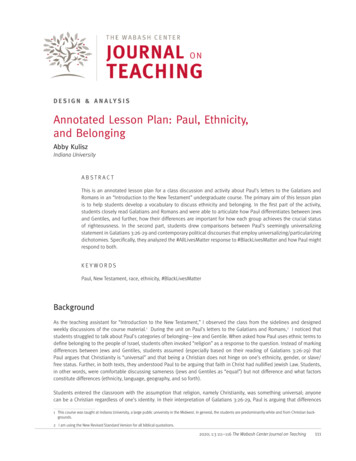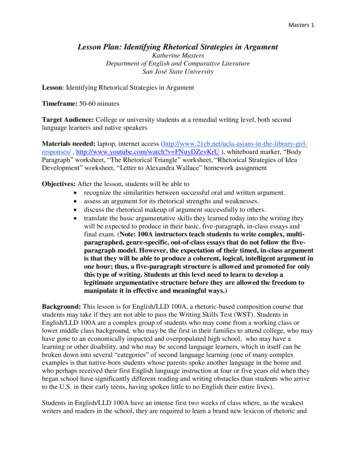
Transcription
Masters 1Lesson Plan: Identifying Rhetorical Strategies in ArgumentKatherine MastersDepartment of English and Comparative LiteratureSan José State UniversityLesson: Identifying Rhetorical Strategies in ArgumentTimeframe: 50-60 minutesTarget Audience: College or university students at a remedial writing level, both secondlanguage learners and native speakersMaterials needed: laptop, internet access rlresponses/ , http://www.youtube.com/watch?v FNuyDZevKrU ), whiteboard marker, “BodyParagraph” worksheet, “The Rhetorical Triangle” worksheet, “Rhetorical Strategies of IdeaDevelopment” worksheet, “Letter to Alexandra Wallace” homework assignmentObjectives: After the lesson, students will be able to recognize the similarities between successful oral and written argument. assess an argument for its rhetorical strengths and weaknesses. discuss the rhetorical makeup of argument successfully to others. translate the basic argumentative skills they learned today into the writing theywill be expected to produce in their basic, five-paragraph, in-class essays andfinal exam. (Note: 100A instructors teach students to write complex, multiparagraphed, genre-specific, out-of-class essays that do not follow the fiveparagraph model. However, the expectation of their timed, in-class argumentis that they will be able to produce a coherent, logical, intelligent argument inone hour; thus, a five-paragraph structure is allowed and promoted for onlythis type of writing. Students at this level need to learn to develop alegitimate argumentative structure before they are allowed the freedom tomanipulate it in effective and meaningful ways.)Background: This lesson is for English/LLD 100A, a rhetoric-based composition course thatstudents may take if they are not able to pass the Writing Skills Test (WST). Students inEnglish/LLD 100A are a complex group of students who may come from a working class orlower middle class background, who may be the first in their families to attend college, who mayhave gone to an economically impacted and overpopulated high school, who may have alearning or other disability, and who may be second language learners, which in itself can bebroken down into several “categories” of second language learning (one of many complexexamples is that native-born students whose parents spoke another language in the home andwho perhaps received their first English language instruction at four or five years old when theybegan school have significantly different reading and writing obstacles than students who arriveto the U.S. in their early teens, having spoken little to no English their entire lives).Students in English/LLD 100A have an intense first two weeks of class where, as the weakestwriters and readers in the school, they are required to learn a brand new lexicon of rhetoric and
Masters 2understand it well enough to write their first paper on a rhetorical analysis of a piece of writingthat they wrote for a previous class. They must write about their writing, a complex task for anystudent, let alone a remedial student. Although complex, it is an important assignment and onethat is extremely beneficial to the students. However, it is also a very intimidating assignment.Therefore, I always like to start my lessons by exploring concepts related to the lesson that theyalready know. I often begin by bringing in media, technology, and pop culture – where they cansee the complex ideas that they are learning about play out in a non-threatening, everyday spacethat they are used to seeing and engaging in.The lesson involves YouTube video clips of arguments produced in the past year by two youngwomen at UCLA. One argument is rhetorically flawed in many ways, while the other is a goodmodel of a strong written argument. Students dissect both arguments for their rhetorical appealsand strategies (or lack thereof) to better understand why one argument was so incoherent, whilethe other was an almost perfect representation of a five-paragraph essay. I have explored portionsof this lesson before in class and allowed students to participate in group discussion about thevideo clips involved in this lesson, but I have never really allowed students to critically think andwrite about the videos afterwards because I have never had time to develop it further. Afterreworking this lesson for the Faculty Writing Workshop, I am confident that this lesson willallow students a chance to engage in critical thinking and writing, even after they receive thelesson. Students also get to take on a role that they do not often get to assume: that of the teacher.In the end, they teach the YouTube student whose argument is flawed the importance ofrhetorical strategies in producing clear writing, and suggest to her ways that she can improve herargument.Introduction to Lesson [5 minutes]:Throughout the first two weeks of this course, you have been given many different handouts onrhetoric, rhetorical analysis, appeals, and strategies. You have taken a diagnostic in-class essayand have started work on your first out-of-class essay, a rhetorical analysis of a paper that youwrote in a previous course. In two weeks, you have been overwhelmed with rhetorical conceptsthat are new and foreign to you. Today, I am going to show you that all of these terms you arelearning are not as overwhelming as you think. You use them all of the time, every day,unconsciously, in any communication where you are attempting to argue with or persuadesomeone. Today, we are going to look at two oral arguments. We are going to take thesestrategies that seem so complex on paper, and analyze them in a different and less intimidatingmedium – video. By the end of the lesson, rhetorical strategies will not seem so daunting, andyou will be teaching them to others.Procedure [approximately 40-45 minutes]:Step 1: Review of the handouts [8-10 minutes]Let us take a look at the three handouts that you received last week: the body paragraphsworkshop, the rhetorical triangle, and rhetorical strategies for idea development. First review therhetorical appeals, then the rhetorical strategies, and then the body paragraph outline. Two ofthe three handouts allow for visual learners to better understand the concepts presented, as theycontain diagrams, as well as text. Ask if there are any questions so far.
Masters 3Step 2: Preview of first video clip [3 min]Does anyone know who Alexandra Wallace is? Has anyone seen her “Asians in the Library”YouTube video? Explain the context surrounding the video. Alexandra is a former UCLA studentwho uploaded a racist rant against Asians talking on their cell phones in the library duringfinals week last Spring 2011. She immediately received so much backlash from it that she feltthreatened to go to class. UCLA student union petitioned to have her expelled. Although UCLAupheld her first amendment right to freedom of speech, they condemned her actions. Alexandrawas so ostracized by the UCLA community that she quit lexandra-wallace-student n 837925.html)What is sadly ironic about this is that UCLA is the university that Mike Rose, the author of thebook(s) you are reading, The Mind at Work and Lives on the Boundary, went to graduate schooland where he is now a professor in the Department of Education. UCLA, the alma mater of aman who has given his adult life to equity in education, is the same institution where AlexandraWallace spewed such hate.Step 3: Show first video [3 min]Let us turn now to the video. As students watch video, have them take notes on the following:What is Alexandra’s purpose for creating the video? Who is her audience? What is her thesis?Video link: http://www.youtube.com/watch?v FNuyDZevKrUStep 4: Analyze first video [10 min]Facilitate discussion about the video: How did it make you feel? If you rip away her racistdiatribe (I know this is hard), and look solely at the structure of her argument, what do you seewrong with her argument? What is her purpose? What is her thesis and where does it sit withinher argument? What rhetorical appeals and strategies does she use? Did she use any of themeffectively? Did she use any of them ineffectively?If students are struggling with this discussion, depending on the time you have in lecture, replaythe video, stopping at relevant points for discussion.Use the whiteboard to diagram what the students see in Alexandra’s argument. As theyvoice their opinions, you might create something like the following chart on the board,representing their ideas visually for them, so they can see the illogical format ofAlexandra’s argument (see next page):
Masters 4 We don’t know what her purpose or whoher audience is right away. She has no thesis. She buries herself right away, stating,“You all know I’m not the most politicallycorrect person in the world, but ” Alexandra lacks organization. She does not give examples of why cellphones in the library are bad; instead, shegoes on a tangent about Asian students. She does use exemplification,description, narration and other rhetoricalstrategies. Alexandra lacks credibility as a “good”student b/c of her tone and her dress. She argues without logos: she statesbiased opinions about students. She shows no empathy for differentcultures; thus, she receives no empathyfrom the audience. Alexandra’s thesis is buried in herconclusion. She proposes no solution to her“problem” of students on their cell phonesin the library. She merely complains aboutit for two minutes.A Sample Diagram of Alexandra Wallace’s ArgumentStep 5: Preview of second video clip [3 minutes]This was posted by a UCLA alum who attempts to educate Alexandra on diversity, culture, andcolonialism. It comes off as thoughtful and to the point.Step 6: Show second video [5 min]As students watch the video, have them take notes on the following: What is the young woman’spurpose for creating the video? Who is her audience? What is her thesis? Have them keep inmind other rhetorical strategies as they watch the video.Video link: l-responses/Step 7: Analyze second video [10 min]Facilitate discussion about the video: How did it make you feel? Look at your “Body Paragraph”worksheet and reflect on the structure of the young lady‟s argument. What do you see? What isher purpose? What is her thesis and where does it sit within her argument? What rhetorical
Masters 5appeals and strategies does she use? Did she use any of them effectively? Did she use any ofthem ineffectively?Next to Alexandra’s argument, use the whiteboard to diagram what the students see in theyoung lady’s argument to Alexandra. As students voice their opinions, you might createsomething like this diagram on the board, representing their ideas visually, so they can seethe very logical and effective format of the young lady’s argument: Right away, we know her audience: UCLA students,faculty, staff, alumni, and Alexandra Wallace. Right away, we know her purpose: to rid UCLA of thekind of ignorance Alexandra displayed by calling for a“diversity requirement” course at UCLA. This requirement would ensure that something likeAlexandra’s rant will not happen again at UCLA. She provides three strong examples as to why adiversity requirement is needed, and she backs them upwith historical and logical facts: 1) She defines the verybroad term, “Asian,” for Alexandra; 2) she remindsAlexandra of our own racist and bloody past asAmericans; and 3) she states that many of thephilosophies that Alexandra is studying actually comefrom Asia. Her tone, lexicon, and clothing establish her credibilityas a thoughtful and serious young woman. She argues logically, providing facts and statistics foreach of the few arguments she brings to our attention. She is smart to not attack Alexandra, but to tell her thatshe is glad that Alexandra brought up the issues she did,and that she “feels sorry” for Alexandra. She is hopefulthat she will change her ways. The young lady restates her thesis that a diversityrequirement is needed at UCLA, and she closes bytalking right to Alexandra, saying that she hopes thatAlexandra is one of those students who calls for adiversity requirement.A sample diagram of student’s rebuttal argument against Alexandra
Masters 6Closure/Evaluation [5 min]:Assign homework assignment “Letter to Alexandra Wallace” (pass out homework handout).Your homework is to write Alexandra Wallace a letter about why her argument was unsuccessful(aside from the obvious racist rant). Help her look at her argument and thesis. Her main thesisstatement is that people should not talk on their cell phones in the library. From what younow know about rhetorical appeals and strategies, point out to Alexandra the flaws in herargument and suggest to her ways that she could have improved it. Do not be angry with her –take the high road. You may briefly mention how her video made you feel, but be sure to remainpositive in your attempt to help her understand rhetoric. End your letter with a positive note, too– perhaps that you hope that she has learned her lesson, and that in argument, every word andevery strategy counts.Lesson Analysis:From the less complex lessons I have created on these videos, I know that students really enjoythe use of technology in the classroom. The two videos I use in this lesson are relatable: these arecollege students who are unconsciously exploring rhetoric, and the videos are recent, posted inthe spring of 2011. It is also a relevant topic, as many of the themes present in the women‟sarguments are themes that are present in the novel we read for class, either Lives on theBoundary, or The Mind at Work, by Mike Rose. Reading about rhetoric is a critical element tothis course, but since students come into 100A with such weak writing and reading skills,providing them with a non-threatening genre of argument (YouTube videos) allows them that“Aha!” moment, where they can see that rhetoric is not a massive puzzle, but an art that theyhave always used, since they first were able to form oral arguments. I think that this lesson willassist students in moving the concept of rhetoric from their unconscious to their conscious.Writing about writing is very difficult, and it takes a strong writer and reader to do it well. I cansee that this assignment might be difficult for some learners in the classroom. During the firsttwo weeks of 100A, students may feel overloaded with the amount of material they receive aboutrhetorical analysis. Trying to understand all the terminology and concepts may take more thantwo weeks of lectures; therefore, I think that instructors of this lesson should have patience whenreviewing the homework assignment at the end of the lecture. If responses are not to one‟sexpectations, I think that perhaps a follow-up lecture on the same themes would be appropriate.“Tell me and I'll forget; show me and I may remember; involve me and I'll understand.”-- Chinese Proverb
Masters 7Sources:Bruno, Crystle. “Body Paragraphs Workshop.” San José State University Writing Center.Handout. 2011.Hadley Porter, Helen. “Rhetorical Strategies of Idea Development and Organization.” MontanaState University Writing Center. Handout. 15 Feb. 2011. torical-strategies Montecillo, Alan. “The 3 Best Responses to UCLA Girl‟s „Asians in the Library‟ Rant.” Video.SuenLabs Media, 2011. Web. 8 Feb. 2012. -responses/ Sunderman, Paul. “The Rhetorical Triangle.” Handout. 8 Feb. 2011. ical%20Triangle.doc “UCLA Student Racist Rant.” Video. YouTube, 2012. Web. 8 Feb. 2012. http://www.youtube.com/watch?v FNuyDZevKrU
Katherine Masters – Identifying Rhetorical Strategies in ArumentPage 1Rhetorical Strategies of Idea Development and Organization: Montana State University Writing CenterHelen Hadley PorterRetrieved on Feb. 15, 2020 from torical-strategiesWhen planning and writing an essay, writers must discover a focused thinking strategy which will help them todevelop their ideas as well as organize them coherently. Unfortunately, often there is no assigned structure orrhetorical approach in a writing task; all the writer may have is an understanding of the topic and his/her purpose.Writers need to understand what a rhetorical strategy is, how a writer discovers an appropriate one to use, and how torecognize a strategy when he/she has used one. Only then can the writer make the choices necessary to consciously andcritically draft and revise.Rhetoric is the study of effective thinking, writing, and speaking strategies; rhetoricians analyze and evaluate whatworks and what does not work in a specific context. Composition and rhetoric studies writing contexts, how texts arecreated, how texts interact, and what features make up an effective written text. To be effective, a text must bedeveloped and organized with a clear context and purpose in mind. Writers must first recognize the rhetorical context,the writing situation, and the purpose their text will serve in this particular context. Writers then need to articulate thispurpose and choose specific rhetorical strategies which will achieve it. Depending on the writing context and thewriter’s thinking style, many writers draft first, then analyze their strategies. Other writing situations demand thatwriters plan first, then execute their strategies. All writers check and recheck their thinking strategies as they revisetheir work.Narration is storytelling and is frequently paired with specific and concrete description in essays with an expressivepurpose. An autobiographical, writer-focused, or personal experience essay will basically be a descriptive narrativewith event, character, and setting developed with specific sensory details. It may be written in the first or third personpoint of view, in the past or present tense, and in chronological or non-chronological order. It may contain dialogue orbe written in a conversational or non-standard voice. An introductory paragraph written to capture the reader’s interestmay be a descriptive narrative. An example used to support an idea may be a descriptive narrative too.Description is present in all strong writing because it provides the significant details which explain ideas. Actionverbs, sharp adjectives and adverbs, and precise nouns create powerful details. These concrete details are the force thatcarries the more abstract ideas; careful word choice and sentence structure are crucial elements of descriptive writing.Strong description relies on sensory details—what we see, hear, taste, smell, and feel to create an impression thereader can experience.Exemplification is the use of examples to explain or elaborate an idea. An essay cannot be just a series of examples;the examples must be unified by a controlling idea. Paragraphs are often developed examples which illustrate a point.But no example can replace logic and evidence; it can only serve to elaborate or clarify a point. Strong writers useexamples in all rhetorical situations and within all other rhetorical strategies regardless whether the purpose is toexpress, inform, or persuade. Examples can help explain definitions, comparisons, processes, classification groupings,and causal relationships. One common use of example is as a vivid and exciting introductory attention-getter.Transitional devices which signal exemplification include for instance, in fact, specifically, to illustrate, such as, forexample.Definitions are necessary to clarify abstractions, explain unfamiliar terms, or distinguish one idea from another similaridea. A short essay may be an extended definition using other rhetorical strategies to develop the main concept. Aparagraph’s purpose may be to define an idea. A term can usually be defined briefly. But avoid the use of the clichédaccording to Webster’s definition. Definitions should create meaning, not just report undigested information. Otherrhetorical strategies such as exemplification, classification, and comparison are necessary when creating a richlydetailed definition.Comparison and Contrast are methods of organizing and developing ideas and often serve as an essay’s primaryrhetorical strategy. Many assignments, whether they are essay exam questions or essay prompts, demand that thewriter explain two or more ideas, one in terms of the other. Comparisons examine similarities; contrasts examinedifferences. Both thinking strategies may be used, or a writer may chose to look at only one. Comparisons such as
Katherine Masters – Identifying Rhetorical Strategies in ArumentPage 2analogies help to clarify complex ideas. Comparisons such as metaphor and simile help to create description withfigurative language. Contrasts on specific criteria often aid in supporting evaluative judgments.The organization of a compare/contrast essay necessitates very careful planning. There are two methods of structure:the side by side (block) method and the point by point (alternate or back and forth) method. The side by side methoddescribes each group separately, but the writer must be very careful to describe each item according to the samecriteria. Two descriptions, however strong and interesting, do not constitute a comparison. Because each item isdiscussed in a block, there will be only one essential transition between the items.On the other hand, a point by point comparison demands very clear transitions, and lots of them, because each criterion(not each group or item) is examined separately. This method allows for more in-depth exploration of the similaritiesand differences and may be more appropriate when the writer wants to persuade the reader to accept an evaluation. Awhole essay based on the compare/contrast strategy usually will rely on this organization; each paragraph will examineone criteria and one item. Clear transitions which indicate comparison include also, in the same way, likewise,similarly. Contrasts are indicated by although, but, however, on the other hand, still, yet, nevertheless, in contrast.Process analysis explores how a phenomena works. A basic cookbook recipe is a process analysis: a descriptivechronology of the stages in the development of a controlling idea. Laboratory reports are also examples of processanalysis, as are many reports on scientific research. Observation papers in the social sciences may also be descriptionsof a process. Descriptions of or directions for technical procedures demand the use of process analysis. Historicalinformation is also often presented in this chronological order. Usually the writer must go beyond a mere blow-byblow narrative and use analytical skills to examine why each step is important to the process and to the final product. Aclear controlling idea is necessary; otherwise the reader is left wondering what the point was? The essay must beunified by this thesis, and the transitions between steps need to keep the essay cohesive. If process analysis is used as asecondary method of idea development, for example to explain the historical background of a topic, make sure that thedescription of the process is pertinent to the controlling idea. Organized writers use strong signals of process analysis:first, second, finally, before, after, meanwhile, as, since, when, then, at the same time.Division and classification is an important rhetorical strategy when the writer wants to analyze and then group similaritems or divide one item up into parts. Classification examines more than one item and then separates the items intogroups according to their similarities on a specific principle or criteria. Critical thinkers rely on the power ofclassification during the analysis of complex information. Research results may need to be classified before they canbe reported. A description or explanation may need to be divided up into useful categories so that the information isorganized and meaningful.By breaking down the whole into manageable and useful parts, a thinker can reach more reliable conclusions. Divisionbreaks one item into meaningful parts and then examines the parts in relationship to the whole. Writing assignmentswhich call for analysis are often asking the writer to parse an idea, event, or text according to specific principles orfeatures. What these principles or features are depends on the discipline and the purpose of the analysis.Analysis of Cause and/or Effect is a very effective method of idea development and organization which is necessaryin almost all rhetorical situations. The exploration of the causes of a phenomena demands that a writer criticallyanalyze the origins of that phenomena. Often, causal analysis is the focusing rhetorical pattern of an essay. Or asignificant part of an essay may be an examination of causes followed by an examination of effects. Or a writer maychose to focus on the analysis of effects with little mention of the original causes. An essay, a paragraph, or a pointmay rely on this essential critical thinking strategy. Many essay examination questions are asking for analysis of causeand effect. But many writers do not recognize when they need to use this rhetorical approach when more in depthcritical analysis needs to be developed.Look for and use important indicators of cause and effect thinking: because, as a result, accordingly, therefore, so,thus. Clarify the exact relationship between the ideas. Ask why, why, why when developing cause and effectrelationships. Cause and effect analysis is often used in conjunction with argumentation, so this rhetorical strategy isfraught with danger. Test for faulty logical connections: when correlation or simultaneousness is mistaken for causalityor when there is insufficient evidence to support the causal relationship.
Katherine Masters – Identifying Rhetorical Strategies in ArgumentHomework: Letter to Alexandra WallaceYour homework is to write Alexandra Wallace a letter about why her argument was unsuccessful(aside from the obvious racist rant). Help her look at her argument and thesis. Her main thesisstatement is that people should not talk on their cell phones in the library. From what younow know about rhetorical appeals and strategies, point out to Alexandra the flaws in herargument, and suggest to her ways that she could have improved it. Do not be angry with her –take the high road. You may briefly mention how her video made you feel, but be sure to remainpositive in your attempt to help her understand rhetoric. End your letter with a positive note, too– perhaps that you hope that she has learned her lesson, and that in argument, every word andevery strategy counts.Guidelines:1. Although you do not want to write a five-paragraph essay as a letter, you do want abeginning and ending to your letter. Give Alexandra your purpose for writing her.Obviously, you are going to use the genre of letter writing, so although we have not goneover this genre in class, keep in mind some things you already know about the format andtone of a letter. Alexandra is obviously your audience, so as one college student toanother, how would you approach her? Using what you know about rhetorical appealand strategy, teach Alexandra not only by telling her how to construct an argument, butalso by providing her a great example – your letter.2. Type and double space your work.Intro: Introduce yourself, yourreason for writing, and three or fourprecise flaws in her argument thatyou want to help her with.What is one flaw in her argument?Don’t just point out the flaw;suggest ways she can improve.Perhaps conclude by offering toshow her more about argument ifshe is interested, suggesting whereto go online for helpful information,or mentioning something elsepositive and effective.What is another area that was weakin her argument? Again, provideexamples for her on ways she canimprove.
Crystle BrunoSJSU Writing CenterRev. Spring 2012Body Paragraphs WorkshopAnatomy of an Essay Introductory Paragraph Introduce the issue. Provide the arguments that will form the bodyparagraphs. Refute any counterpoints to the argument. End with the thesis statement. Body Paragraphs Begin with a topic sentence that reasserts the thesis. Support the argument with information fromsources such as journal articles or scientific studies. Provide 1-2 sentences explaining each quote. Provide 1-3 sentences indicating the significance ofeach quote. Ensure that the information supports and is relevantto the thesis statement. End with a transition sentence that leads into thenext body paragraph. Concluding Paragraph Stress the argument of the paper. Briefly summarize main points. Provide an effective close for the paper. Leave the reader with a meaningful idea or questionIntroductionBody ParagraphsFirst Supporting ArgumentSecond Supporting ArgumentThird Supporting ArgumentA paper may contain as many bodyparagraphs as needed to prove the thesis.Conclusion
Crystle BrunoSJSU Writing CenterRev. Spring 2012Anatomy of a Body ParagraphTopic SentenceSourceTopic Sentence A sentence that reflects the argument of the thesisstatement.Source An informative sentence or group of sentences quotingor paraphrasing a book, journal article, or other sourcethat supports the argument or thesis of the paper.ExplanationExplanationQuote: one to two sentences that clarify the informationprovided by the source in your own words. Paraphrase: Since a paraphrase is information from asource in your own words, you should have alreadyclarified or explained the source. Significance(Repeat at needed in each paragraph)Transition SentenceSignificance or So What? One to three sentences that specify the significance orimportance of the source to the argument of the paper.Transition Sentence A sentence that leads into the argument of the followingbod
language learners and native speakers Materials needed: laptop, internet access . One argument is rhetorically flawed in many ways, while the other is a good model of a strong written argument. Students dissect both arguments for their rhetorical appeals and strategies (or lack thereof) to better understan


